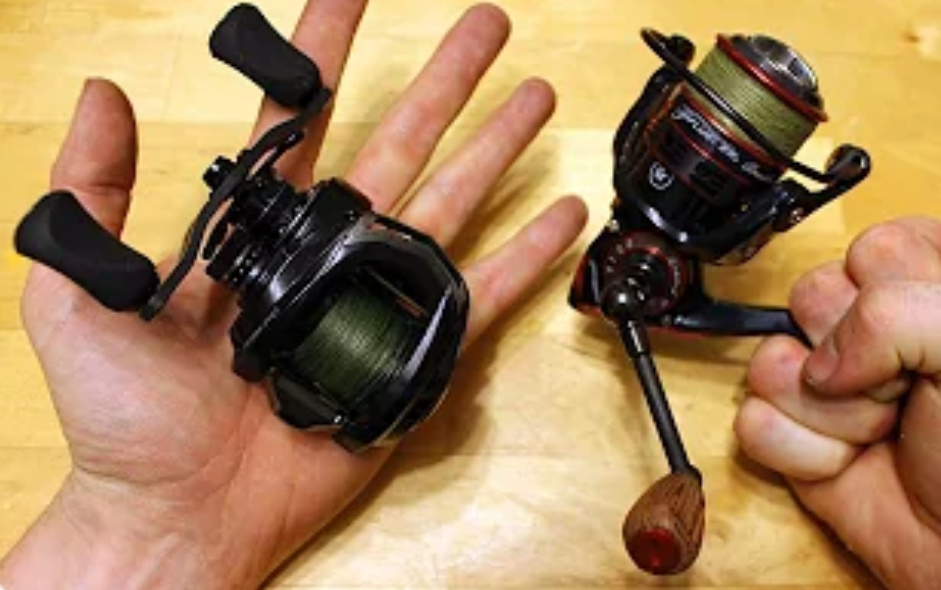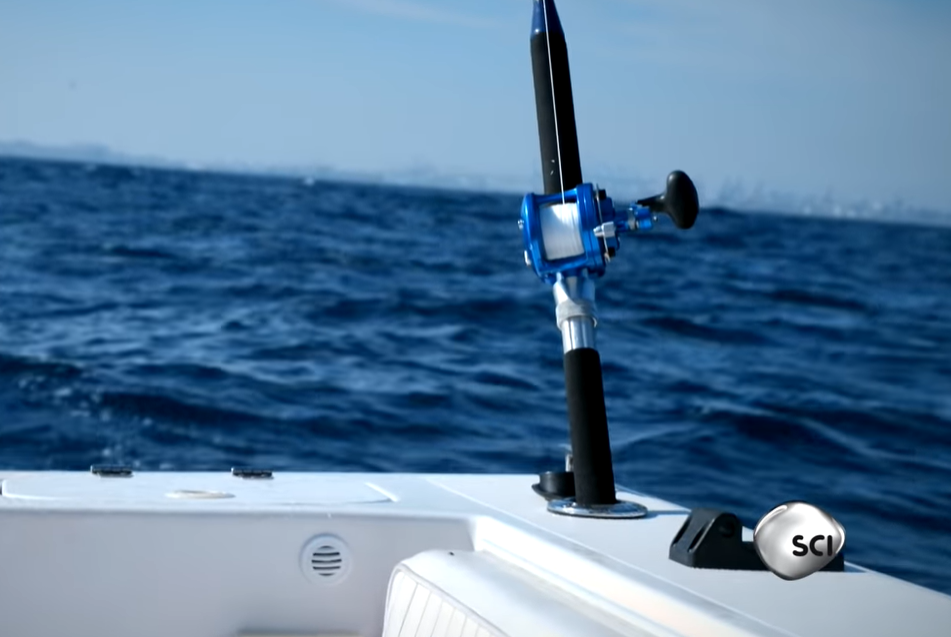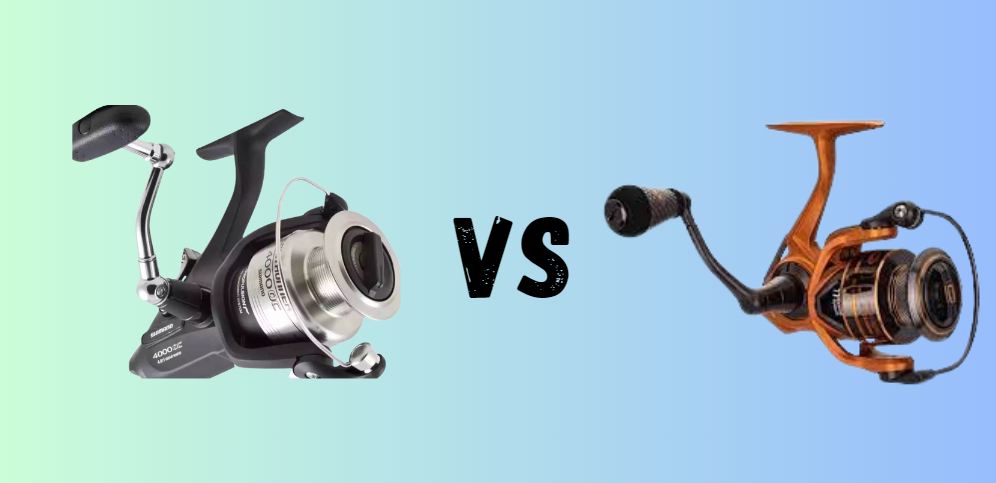A bait runner reel has a dual drag system allowing freeline spooling, while a regular spinning reel utilizes a single drag mechanism. Baitrunner reels enable bait to move naturally after a bite without feeling the drag.
When it comes to fishing reel selections, anglers often debate the merits of a baitrunner versus a standard spinning reel. Understanding the features of each type can significantly improve your fishing experience. Baitrunner reels, also known as free-spool or live-liner reels, are unique in their ability to let fish take the bait and run with it because of the secondary drag system, without the need to open the bail arm.
This feature is particularly beneficial when targeting wary fish. Traditional spinning reels, on the other hand, are favored for their simplicity and versatility, being suitable for a wide range of fishing techniques and species. Deciding between the two depends on your specific style of fishing and the species you’re aiming to catch. What is the Difference between a Baitrunner And a Spinning Reel?

Introduction To Fishing Reels
Fishing enthusiasts know that a successful day by the water hinges not only upon skill and patience but Also upon the gear in hand. Central to this gear is the fishing reel, a sophisticated device that has transformed angling into the art it is today. From beginner hobbyists to seasoned pros, understanding the nuances of different reel types can make all the difference. Let’s cast a line into the heart of fishing reels.
The Evolution Of Modern Fishing Reels
Fishing reels have undergone remarkable transformations since their inception. Initially, reels were simple, manually operated spools that were more about storage than function. Advancements in technology and design have led to the development of highly specialized reels. Modern anglers benefit from features like drag systems, gear ratios, and many casting technologies, all of which combine to provide efficiency and precision in the angling experience.
Overview Of Reel Types: Baitrunner And Spinning Reels
When it comes to selecting a reel, fishermen are met with a myriad of options, each tailored to different fishing situations and species. Among the plethora, two popular types stand out: the Baitrunner and the Spinning Reel.
- Baitrunner reels, also known as free-spool reels, feature a dual drag system. This design allows the reel to switch between a regular drag setting for fighting fish and a secondary drag system that lets fish take the bait and run with it, without the need for the angler to open the bail. This makes it an ideal choice for live bait angling.
- Spinning reels, on the other hand, are versatile and user-friendly. They boast a fixed spool with an open bail, around which the line is wound. Anglers cast the line by flipping the bail, allowing for precise and distant casting. Their ease of use and adaptability make them a go-to for many fishing enthusiasts.
Both reel types are fundamental in modern angling and serve unique purposes geared toward elevating the fishing experience.
Understanding The Baitrunner Reel

Fishing enthusiasts often debate the merits of different types of fishing reels, particularly when it comes to bait runner reels versus spinning reels. The bait runner, also known as a free spool or bait feeder reel, boasts a dual-drag system that sets it apart from the traditional spinning reel. This specialized reel allows anglers to have a secondary drag system, which offers unique advantages when fishing. Let’s Plunge into the world of bait runner reels and understand their functionality, ideal use cases, and the pros and cons associated with their use.
Functionality And Design Of Baitrunner Reels
Baitrunner reels are ingeniously designed with a dual drag system. The primary drag functions like any conventional spinning reel, maintaining control during the fight with a fish.
What sets the bait runner apart is its secondary drag system, which can be engaged or disengaged with a flip of a switch or lever conveniently located at the base of the reel. When activated, this system allows the line to flow freely off the spool with minimal resistance, making it easier for fish to take the bait without feeling the weight of the reel—providing an excellent opportunity for a successful hook set once the angler re-engages the primary drag.
Ideal Use-cases For Baitrunner Reels
The bait runner’s unique design makes it particularly advantageous for certain fishing scenarios:
- Still Fishing: Enables the angler to let the fish run with the bait, particularly useful when targeting shy or cautious species.
- Live Bait Fishing: Perfect for allowing live bait to move naturally without the constraint of reel tension.
- Bottom Fishing: Essential when fishing at the bottom, as it permits a fish to take the bait and move off without feeling the resistance from the reel.
Pros And Cons Of Using A Baitrunner
| Pros | Cons |
|---|---|
|
|
In summary, bait runner reels offer a distinctive advantage for anglers who need direct control over their line resistance and intricate delivery of bait. Armed with knowledge of these reels’ functionality, ideal use cases, and their benefits and downsides, anglers can make informed decisions that align with their fishing strategies and goals.
Exploring The Spinning Reel

Understanding the dynamics and utility of spinning reels is essential for both seasoned anglers and novices venturing into the world of fishing. These reels boast a design that is user-friendly and versatile, suitable for a wide range of fishing experiences. Delving into the spinning reel’s features offers insight into its widespread popularity.
Mechanics And Construction Of Spinning Reels
Spinning reels consist of several key components that work in harmony to provide a smooth fishing experience. The main body, typically made of graphite or aluminum, houses the gearing mechanism and supports the entire structure. Attached to it is the spool which holds the fishing line, and the handle that anglers rotate to retrieve the line.
A unique characteristic is the fixed spool, around which the line uncoils during a cast. The bail arm, a metal loop, guides the line back onto the spool when reeling in. The whole system is supported by a drag system, allowing anglers to adjust the resistance against a hooked fish, thereby preventing the line from snapping under stress.
Applications And Suitability Of Spinning Reels
- Beginner-Friendly: Spinning reels require minimal skill to use, making them ideal for beginners.
- Versatile: They handle a wide range of bait and lures, suitable for different fishing styles and environments.
- Light Tackle Fishing: Excelling in handling light lines and lures, they’re preferred for delicate presentations.
Whether targeting small freshwater fish or venturing into inshore saltwater fishing, spinning reels adapt well to many scenarios.
Advantages And Disadvantages Of Spinning Reels
| Advantages | Disadvantages |
|---|---|
| Easy to Use: Low learning curve, easy to cast and manage. Adaptable: Works with many fishing techniques and environments. Less Line Twist: Fixed spool reduces line twisting and knotting. | Line Twist on Long Casts: Potential for line issues on longer casts. Limited Drag Power: Not always suitable for very large fish or heavy drags. Variable Durability: Construction quality varies by brand and model. |
Considering these advantages and disadvantages is crucial when selecting a reel for specific fishing conditions or preferences. Spinning reels offer a balance between functionality and ease of use, making them a staple in the tackle boxes of many anglers around the globe.
Comparative Analysis: Baitrunner Vs Spinning Reel
Understanding the key differences between a bait runner and a spinning reel is essential for anglers who wish to tailor their gear to the specific situations they encounter. While both can serve a fisherman well, they operate on different mechanisms and suit many fishing scenarios. Let’s Commence a comparative analysis to dissect the functionality and appropriate applications of each reel type.
Drag Systems: The Dual Drag In Baitrunners Versus The Front Drag In Spinning Reels
The drag system in a fishing reel is crucial as it applies pressure to a hooked fish and allows the line to unreel in a controlled manner. Baitrunner reels stand out for their dual drag system. This unique feature provides two separate settings: one for the initial bite and another for fighting the fish. The preliminary drag is lighter, letting the fish take the bait and run without feeling resistance, thereby reducing the risk of a spit hook. Once the angler is ready to engage, a flip of the switch activates the stronger, secondary drag for the battle.
In contrast, standard spinning reels typically feature a front drag system, with a single adjustment knob located on the spool’s front. While this system is reliable and effective for many fishing scenarios, it does not offer the bait runner’s level of finesse for the initial take.
Ease Of Use And Learning Curve
For newcomers to fishing, spinning reels are often the go-to. Their design is simple and intuitive, making the learning process straightforward. Spinning reels are versatile and can be used in most fishing situations with minimal instruction. The operation involves opening the bail, casting the line, and then managing the drag and retrieve with a single handle.
Conversely, a bait runner reel requires a bit more understanding due to its dual drag system. Anglers must learn how to effectively switch between the two drag settings to improve their advantage. This small learning curve can be quickly mastered with practice, but it does present an initial hurdle that spinning reels do not.
Target Species And Techniques: Which Reel For Which Fish?
- Baitrunner reels are ideal for:
- Carp fishing
- Live bait fishing in saltwater
- Specimen hunting, where a sensitive drag is necessary
- Spinning reels are well-suited for:
- All-around freshwater and inshore saltwater fishing
- Techniques that involve frequent casting and retrieving
- Beginner anglers due to their ease of use
Choosing the ideal reel depends on the target species. Baitrunners excel with larger, fight-prone fish where the dual drag system can make a significant difference. Meanwhile, spinning reels offer flexibility and simplicity, making them suitable for a wide array of species, from small trout to larger bass.
Making The Choice: Find Your Perfect Reel
Faced with the diverse world of fishing reels, anglers might find themselves puzzled by the nuanced differences of types like bait runners and spinning reels. Each offers distinct advantages that could redefine your fishing experience. Identifying the most suitable reel collaborates with understanding your angling ambitions, the environments you frequent, and your budget. Ready to reel in that perfect match? Let’s Plunge into the considerations that will steer you to the ideal reel for all your fishing ventures.
Assessing Your Fishing Needs And Goals
Understanding your fishing objectives is paramount in choosing between a bait runner and a spinning reel. Baitrunner reels, also known as free-spool reels, possess a unique dual drag system that allows fish to take the bait and run with it, sans resistance.
This functionality is ideal for targeting larger fish or those known to be easily spooked. In contrast, the spinning reel is more versatile, catering to a variety of fishing techniques from light to medium bait. It’s a top pick for precision and ease of use, suitable for both novice and seasoned anglers.
- Baitrunner Reel – Best for larger species and live bait tactics
- Spinning Reel – All-purpose, user-friendly for diverse fishing styles
Environmental Factors Affecting Reel Selection
Selecting a reel is not only about technique but also about the environment in which you’ll be fishing. Saltwater environments, teeming with corrosive elements, demand a reel that boasts anti-corrosive properties. Freshwater counterparts might not be as demanding, allowing for more flexibility in material selection.
Baitrunner reels often offer substantial build quality to handle the bigger game, while spinning reels can be more diverse but may need special treatment for saltwater use. Always verify the reel’s capacity to endure your chosen fishing grounds.
| Reel Type | Environmental Suitability |
|---|---|
| Baitrunner Reel | Better for harsh environments, durable construction |
| Spinning Reel | Flexible, may need protection in saltwater settings |
Budget Considerations And Reel Durability
Pricing often aligns closely with durability and the reel’s feature set. Premium materials such as carbon fiber or high-grade aluminum contribute to higher costs but result in a resilient reel that withstands the test of time and the elements.
Budget-friendly options are abundant, specifically within the spinning reel category, providing adequate functionality without breaking the bank. Nonetheless, investment in a more durable bait runner could translate to better long-term value, especially for specialized anglers targeting large games.
- Higher-end reels – More durable, long-term value, better for regular users
- Budget-friendly reels – Adequate for casual anglers, may require replacement sooner
In the end, the equilibrium between price and quality must be balanced with one’s personal fishing frequency and dedication to the sport. The correct reel choice manifests when these factors converge to improve your fishing, not hinder it.
Maintenance And Care For Longevity

Ensuring your fishing reels last for years comes down to regular maintenance and adept care. Whether you’re unwinding with a Baitrunner or casting lines with a spinning reel, understanding how to keep these tools in top condition is key to a successful fishing experience. Let’s probe into essential care tips and troubleshoot common issues that might arise, as well as consider when it’s time to seek professional servicing for your favorite reels.
Routine Maintenance Tips For Both Reel Types
Routine maintenance is the cornerstone of reel longevity. Here are some universally applicable tips for keeping both Baitrunner and spinning reels performing optimally:
- Clean after use: Rinse your reels with fresh water to remove salt, dirt, and grime.
- Inspect regularly: Check for any signs of wear and tear before and after outings.
- Lubricate parts: Use a high-quality reel oil to lubricate moving parts and prevent corrosion.
- Check drag system: Ensure the drag is smooth and adjust tension appropriately.
- Store correctly: Keep your reels in a cool, dry place, and if possible, hang them vertically.
Troubleshooting Common Issues
Despite diligent care, reels can develop issues. Recognize and rectify common problems to avoid disruptions during your next fishing trip:
| Issue | Baitrunner | Spinning Reel |
|---|---|---|
| Line Twists | Check for proper spooling and bait runner tension. | Ensure correct line installation and bail function. |
| Erratic Drag | Clean and lubricate drag washers. | Disassemble and inspect the drag system. |
| Unresponsive Bail | N/A | Clean and lubricate bail hinges and springs. |
Professional Servicing And Parts Replacement
At times, reels might need more than just simple at-home care. Professional servicing ensures a comprehensive checkup, and parts replacement is handled with expertise:
- Seek to service yearly or after extensive use or if encountering persistent issues.
- Professionals can replace worn-out gears, bearings, and other components with precision.
- OEM (Original Equipment Manufacturer) parts are recommended for compatibility and performance.
Keeping up with these steps can greatly extend the life of your reels and ensure they are ready for your next angling adventure.
Frequently Asked Questions On What Is The Difference Between A Baitrunner And A Spinning Reel
What Are Baitrunner Reels Good For?
Baitrunner reels are ideal for live-lining fishing tactics, allowing fish to take the bait and run without feeling resistance. They enable easy tension adjustment, providing versatility for many fishing conditions.
Why Are Baitcasters Better Than Spinning Reels?
Baitcasters offer improved control for precision casting and handle heavier lines and lures efficiently, making them superior for certain fishing techniques. They also provide better drag systems for large fish and are favored by experienced anglers seeking performance and accuracy in their casts.
What Are Bait Casting Reels For?
Baitcasting reels are designed for precision fishing and handling heavier line and lures. They offer superior control to anglers targeting larger fish.
Can You Use A Baitrunner Reel For Float Fishing?
Yes, you can use a baitrunner reel for float fishing as it allows for controlled free spooling and quick engagement of the drag system when a fish takes the bait.
Conclusion
Understanding the distinction between baitrunner and spinning reels is key for any angler. Each type offers distinct advantages for specific fishing scenarios. Opt for a baitrunner when you need the free-spooling feature, and choose a spinning reel for its versatility and ease of use.
Tailoring your gear to your technique ensures a better fishing experience.

